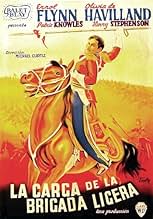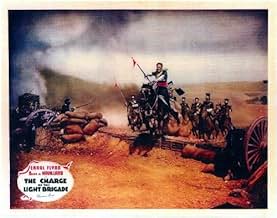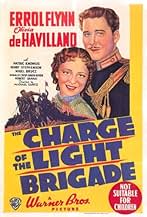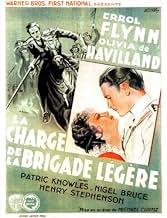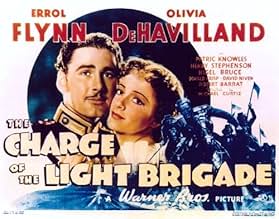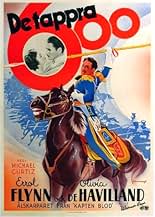La charge de la brigade légère
- 1936
- Tous publics
- 1h 55min
Suite au conflit impliquant l'Angleterre et la Russie, un officier des Indes est chargé de partir en Arabie pour fournir l'armée en chevaux. Pendant ce temps, la garnison est attaquée par le... Tout lireSuite au conflit impliquant l'Angleterre et la Russie, un officier des Indes est chargé de partir en Arabie pour fournir l'armée en chevaux. Pendant ce temps, la garnison est attaquée par le sultan Surat Khan, nouvel allié des Russes.Suite au conflit impliquant l'Angleterre et la Russie, un officier des Indes est chargé de partir en Arabie pour fournir l'armée en chevaux. Pendant ce temps, la garnison est attaquée par le sultan Surat Khan, nouvel allié des Russes.
- Réalisation
- Scénario
- Casting principal
- Récompensé par 1 Oscar
- 4 victoires et 3 nominations au total
- Major Jowett
- (as G. P. Huntley Jr.)
- Subadar-Major Puran Singh
- (as J. Carroll Naish)
- Prema's Mother
- (as Princess Baigum)
Avis à la une
Good film with lavish production values dealing with events leading up to British involvement in Crimean war with stunning final battle sequence . This epic movie contains feats , a romantic love story , adventures , thundering action , thrills , and historical events . The film was originally set entirely in India, but the Crimean War was added due to fears by Warner Brothers that the story was too similar to Paramount's The lives of a Bengali Lancer (1935). Exquisitely made battle scenes being magnificently directed by action specialist B. Reeves Eason . Although during the filming of the charge sequence, a stuntman was killed when he fell off his horse and landed on a broken sword that was lying on the battlefield . The original script used the real-life siege of a British fort at Cawnpore , and subsequent massacre of its survivors , during the Sepoy Rebellion -, a nationwide mutiny of Indian soldiers in the British army - as the reason for the famous Charge of the Light Brigade at Balaklava during the Crimean War . The second of nine movies made together by Warner Brothers' romantic couple Olivia de Havilland and Errol Flynn , here playing star-crossed lovers . The success of this film set the seal on Olivia and Errol Flynn's super-stardom . The support cast is frankly excellent such as Patrick Knowles , David Niven , C. Henry Gordon , Henry Stephenson , Nigel Bruce , Donald Crisp , EE Clive , Roger Barrat and J. Carrol Naish . The picture climaxes with one of the most dramatic and immortal cavalry charges in history . For the filming of the climactic charge, 125 horses were trip-wired ; of those, 25 were killed outright or had to be put down afterward . Superb and evocative cinematography in black and white by Sol Polito , though is also shown in a lousy computer-colored version . Breathtaking score by the maestro Max Steiner in his first one for Warner Brothers . The motion picture produced in big budget by Hal B. Wallis , Harry Warner and Jack Warner was compellingly realized by Michael Curtiz .
Flynn has a role tailor-made to his specifications, the noble hero who looks even more splendid than ever wearing a trim mustache and military uniform. The script, in a twist, has his brother (PATRIC KNOWLES), who looks enough like Flynn to be his real brother, winning over the heart of the heroine (OLIVIA de HAVILLAND) at a military outpost in India. Flynn, as Major Vickers, decides to avenge the massacre of British women and children at the fort, thus forging the orders that lead to the famous charge.
All of it is strictly meant to entertain, offering political background of a confusing sort to give an idea of the events surrounding the charge. While all of it has been falsified for the sake of providing a screenplay that makes Flynn the noblest of heroes, there is no denying the epic sweep of the derring do and romance.
Flynn and screen partner de Havilland make a handsome couple and they are supported by a fine bunch of actors from Hollywood's British film colony, notably Patric Knowles, David Niven and Donald Crisp. Max Steiner has provided one of his best military background scores that gives added dimension to the exciting battle scenes.
For Flynn fans, this is a must see. For anyone expecting to see an historical account of the Charge, better tune in to the History Channel for that sort of stuff. But as entertainment, CHARGE OF THE LIGHT BRIGADE delivers the goods and should make Flynn and de Havilland fans happy.
Flynn, with his trademark moustache restored, is Major Geoffrey Vickers, dashing British Lancer, who, as the film opens, saves the life of Indian ruler Surat Khan (played by veteran screen villain C. Henry Gordon) during a tiger hunt. While Khan despises the British, he has a blood debt to Vickers, which must be honored.
Between assignments, Vickers tries to be the devoted fiancé of beautiful Elsa Campbell (de Havilland), but in a twist from the usual Flynn/de Havilland teamings, she actually loves his brother, Perry (Patric Knowles, who would later play 'Will Scarlet' in ROBIN HOOD). The love triangle subplot is the least effective part of the story; fortunately, these interludes don't last long!
Courting favor with the Russians (represented by Stalin look-alike Robert Barrat), Khan gambles, correctly, that the British would never consider him capable of murdering women and children, so his attack on an undermanned Chukoti, and the subsequent massacre of all the inhabitants (save Vickers and Campbell, thus fulfilling his blood debt), creates a furor that rocks India, and a evokes a vow of revenge from Vickers and the Lancers, who'd lost all of their loved ones. Khan flees the country, joining his Russian allies in the Crimea.
Just in time to fulfill the title, the Lancers are reassigned to the Crimea, and discover that Khan is located with the cannon emplacements on the Balaclava Heights. Arranging to get his brother safely away from the action, Vickers forges orders to have the Light Brigade attack the Heights, and 'The Charge' begins...
While the Charge (created by second unit director "Breezy" Eason) is one of the most incredible scenes ever recorded on film, with hundreds of horsemen galloping in formation 'to the guns', there was a deadly price for the spectacle; the buried explosives and trip wires used to create realistic cannon blasts injured many horses, resulting in a large number of animals having to be 'put down'. Humane societies nationwide (and Flynn, himself, who was appalled by the needless slaughter) raised such an outcry that standards were established barring cruelty to animals, which are still in effect today.
Besides Flynn's heroic performance (yes, that really IS him, leaping a cannon on horseback), Donald Crisp, Henry Stephenson, and J. Carrol Naish (as an Indian) provide memorable support. And watch for a young David Niven, as Vickers' doomed fellow officer. Flynn and Niven were great friends, sharing a cottage in Malibu (nicknamed 'Cirrhosis-by-the-Sea', because of their wild parties), and their final scene together is far more poignant than any Flynn/de Havilland moments in the film!
While flawed, historically, and unquestionably bloody, THE CHARGE OF THE LIGHT BRIGADE retains its position as a 'classic', and proved to the WB that Errol Flynn was not just a 'one hit wonder'. Great things were ahead for the young star!
I watched this film without really knowing what to expect of it. I knew Errol Flynn was in it, so I expected an adventurous movie with lots of memorable action sequence. The movie started of just like Michael Bay's "Pearl Harbor", with a love triangle story between the Errol Flynn character, his brother played by Patric Knowles and Olivia de Havilland. Flynn and de Havilland surely are one of the best screen couples of all time, so those moments are still better and more enjoyable than your average '30's love filled drama. But just like "Pearl Harbor" the best moments of the movie are in the second part, in the action sequences. The movie takes epic proportions in its action sequences, which are big and spectacularly brought to the screen. It makes the first part of the movie feel kind of obsolete and yes, it is definitely true that you can basically skip the whole first part of the movie, with the exceptions of a few sequences maybe, which are important for the development of the story and certain characters.
The story itself is quite fascinating, with the exception of the whole love triangle thing of course. It's based on true events, although the movie takes lots of liberties with the story but this really does the movie no harm. It doesn't make the actions of the light brigade seem any less noble or heroic, so the movie does the true story justice in my opinion. The several plot lines of the story are well developed in the story. I especially like the sequences with the political game between Surat Khan and the Russians with the British. There are some subtle sequences with some very well written and clever dialog. The drama in the movie is also surprisingly heavy. When you watch an Errol Flynn action flick you expect to see some lighthearted fun action sequences but in this movie the action is heavy, powerful and dramatic.
The cast is great! Errol Flynn is in his element as the popular and noble gentleman Maj. Geoffrey Vickers. Olivia de Havilland is also fine as always and it also was great to see David Niven in one of his first roles before he received real fame as an actor. It's amazing to see that he basically already looked the same in this movie as he did in movies that were made 40 years later. His role is quite small and not really significant but his presence is notable. Also really great was C. Henry Gordon as the cold-hearted villain Surat Khan, which starts of like a much warmer character. As the movie progresses he becomes more and more ruthless and he turns into almost a James Bond like villain, which works actually very well for such an adventurous action filled epic like this movie.
Based purely on all those things I just mentioned I would had rated this movie an 7 out of 10. But then came the ending...
Quite honestly, I was blown away by the ending. I simply did not expected to see such a large scale, complex action sequence in a 1936 movie. The charge in which literally hundreds of cavalry men, attack a Russian stronghold which is supported with numerous cannons is impressive to say the very least. Seeing all those hundreds of cavalry men, with Errol Flynn of course in front, riding up through the valley of death to an almost certain doom is extremely powerful. These are not CGI horses like for most part was the cast in the Lord of the Rings trilogy, this is the real thing! Horses and men flying around by the firing cannons and Errol's friends dying around him, as they come more and more closer to the Russians and Surat Khan. It such a arousing and spectacular filmed sequence that it still holds up by todays standards. Unfortunately also hundreds of horses and one stunt person got killed during the filming of the end charge. But to be honest, 1 person seems so few when you look at that sequences. I mean, men are flying and dropping from their horses like puppets, while horses ride around them within close range!
A classic epic. See this movie, if already alone for the unforgettable, arousing end charge of the light brigade.
8/10
http://bobafett1138.blogspot.com/
Le saviez-vous
- AnecdotesFor the filming of the climactic charge, one hundred twenty-five horses were trip-wired. Of those, twenty-five were killed outright or had to be put down afterward. The resulting public furor caused the US Congress to pass laws to protect animals used in motion pictures. Star Errol Flynn, a horseman, was so outraged by the number of horses injured and killed during the charge, and by director Michael Curtiz's seeming indifference to the carnage, that at one point as he was arguing with Curtiz about it, he could contain himself no more and actually physically attacked him. They were pulled apart before any serious damage was done, but it put a permanent freeze on their relationship; even though they made subsequent films together, they despised each other and would speak only when necessary on the set.
- GaffesAfter the massacre, Flynn sympathetically listens to Major Singh crying over the body of his murdered son Prema who is clearly wiggling his toes in the foreground of the scene.
- Citations
[first lines]
Sir Humphrey Harcourt: How do you fellows manage to look so comfortably, Vickers?
Major Geoffrey Vickers: We may look it Sir, but we're not. They say the first forty years are about the hottest up here on the frontier, after that you get used to it.
Sir Humphrey Harcourt: Really?
- Crédits fousOpening credits: This production has its basis in history. The historical basis, however, has been fictionized for the purposes of this picture and the names of many characters, many characters themselves, the story, incidents and institutions, are fictitious. With the exception of known historical characters, whose actual names are herein used, no identification with actual persons, living or dead, is intended or should be inferred.
- Versions alternativesAlso available in a computer colorized version.
- ConnexionsFeatured in Hollywood and the Stars: The Swashbucklers (1964)
- Bandes originalesGod Save the Tsar
(uncredited)
Music by Alexis Lvov
[The Russian national anthem from 1833 to 1917 played as part of the score during the charge at Balaklava]
Meilleurs choix
- How long is The Charge of the Light Brigade?Alimenté par Alexa
Détails
- Date de sortie
- Pays d’origine
- Langue
- Aussi connu sous le nom de
- La charge fantastique
- Lieux de tournage
- Lake Sherwood, Californie, États-Unis(massacre at the boats)
- Société de production
- Voir plus de crédits d'entreprise sur IMDbPro
Box-office
- Budget
- 1 200 000 $US (estimé)
- Durée
- 1h 55min(115 min)
- Couleur
- Mixage
- Rapport de forme
- 1.37 : 1



